Home > Welcome > Sleep-wake pathologies > Know how to sleep > From the infant to the teenager
From the infant to the teenager
Thursday 4 October 2007
All the versions of this article: [English] [français]
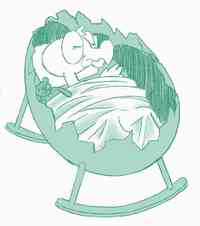
- Insomia is often learned in the cradle
Sleep is a physiological need but a child must not be forced to sleep because sleep cannot be commanded by will and the adult’s insomnia is often rooted in childhood.
Caution (for the parents) :
From when it is two years old, a child is able to understand that it feels bored in its bed.
When it is the case, it protests as soon as it is laid to sleep and anger and tears maintain the insomnia until exhaustion wins (at last).
The « badly » sleeping child learns very early, that way, to fear the period before sleep (very worrying, to him).
Like for the insomniac adult, one must be able to use the « 20 minutes rule »:

- Bedtime?...
If sleep onset is not effective after 20 minutes in bed, it is better to « free » the little one from the wait and let it go back to calm plays for a similar period of 20 minutes.
It is the ideal time to listen to a story and even to take a little bath.
The next morning, the child must not be left to sleep longer than usual in order not to maintain a sleep delay the following evenings.
The products « for sleep » (even homepathic) have no medical justification. That attitude generates a distrust for falling asleep which feeds the vicious circle of insomnia in the child (and maintains it in the parents).
The infant and the child’s sleep
The newborn baby sleeps a lot, in average 16 hours a day. But it is from birth on that important differences from one baby to another (who live under the same conditions in maternity hospital) can be measured.
"Some babies sleep more than 20 hours, others only need 14 hours, without it being abnormal".

- A problematic testimony
Often, 50% of that additional wake is made of cries in the short sleeper, which leaves the familiy with the memory of a difficult baby (it screams at least 3 hours a day more than the long sleeper who sleeps through the nights).
The child between 6 months and 4 years will gradually reduce its diurnal sleep time by skipping the morning nap more and more, and then that of the afternoon.
It goes from three to four daily naps before 6 months to two around twelve months, and then only one around 18 months.
The total sleep duration only decreases very gradually, the disappearance of the naps goes with an extension of the night sleep.
- at the age of 6 months, the child sleeps 15 hours in average;
- 13-14 hours around the age of 2 years;
- more or less 12 hours between 3 and 5 years.
Nb. The figures published here are only averages. The individual need for sleep changes probably even more with children than with adults.
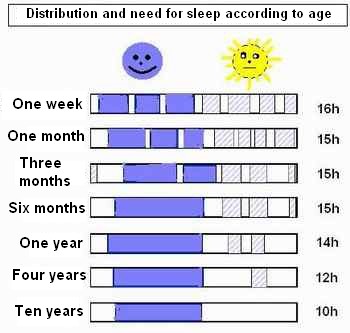
- Source : ProSom
"My baby cries at 6-7 PM, every evening"

Many mothers are worried and helpless in front of these incomprehensible episodes (the small one looks like it is suffering very hard).
Yet, the numerous doctors that have been seen find nothing wrong ... (sometimes, parasites, teeth, or constipation are mentioned).
- These very stereotypical attacks match phases of excitement which take part in the child’s brain’s maturation.
- Besides, the infant has to adapt its sleep-wake cycle to the requirements from its environment. That way, it goes from a "free running" polyphasic to an essentially nocturnal biphasic rythm.
- The transition between the chronobiological rythms often causes a sleep debt which the baby (who doesn’t know sleepiness) expresses through a state of general excitement.
The attacks are typical : the baby cries, calms down, then it makes a grimace, tenses its belly, contracts itself in flexion (which often causes a worrying gas...).
It screams again, refuses to drink, doesn’t want to cuddle...... sometimes the baby is excited because it is tired...
That state can be compared to that of an insomniac subject who is looking for sleep while he/she is too "excited from tiredness" to fall asleep.
The "infant colics" are thus often signs of shifted sleep in the baby.
They occur in the end of the day (between 3 and 18 months), their rythm doesn’t depend on the meals and they are not relieved by the meals either.
That symptom must often be analyzed with the help of a sleep-wake diary. Are there factors that harm the baby’s sleep during the naps ? :
It is necessary to insist on the importance of noise because "the ears do not have lids". It has been demonstrated that noise disturbs the baby’s sleep a lot even if it will not wake up from it, but will show signs of tiredness. It will be more restless and capricious.
Elsewhere, it will be a better management of the naps (duration, schedules), more adapted to the baby’s rythm, that will help make these colics disappear.
Nb. The colics must not be confused with cries of anger of the small one who is not sleepy and which can be solved with the help of the "20 minutes rule".
A sleep one dreams of :
(The poorly sleeping adults often have the nostalgia of their small childhood’s sleep).
In the evening, the child of 4 to 10 years usually falls asleep very fast in a very deep sleep.
From the morning, it is fully awake and, during the day, it is very vigilant (it is very rare to see a child fall asleep in front of the television).
It is at that age that it gradually loses the need to have a nap.

The start of the afternoon should though be reserved for a moment of free time when the child who wishes to can go to sleep for a couple of minutes (30/45).
If it is not sleepy, like it can be seen in some short sleepers (or in the case of a phase delay due to Sunday’s sleep over or the too late naps), it is useless to impose a too long rest on the child. It will then be necessary to respect a fixed schedule for getting up and to change the nap hour.
During that period, the total sleep time decreases and becomes lower than 12 hours. That reduction of the total sleep time is related almost entirely to the disappearance of the nap.
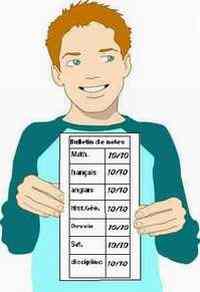
- The best pupil of the class...
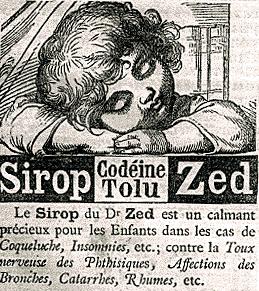
- A tranquillizer for children?
Nb: In our experience, insomnia doesn’t have any effect on the school or relational performances of the children who are, most of the time, very good pupils and present no behaviour disorder.
In the opposite case, insomnia may be the symptom of an underlying psychological illness, which requires the opinion of a child psychiatrist.
Except for some very exceptional cases, insomnia in children should not lead to the prescription of sleep medications.
Some "harmless and light sedatives" are (still) sold for that purpose but, in our opinion, the even symbolic use of these products reinforces a pathological relation around sleep between the parents and the child which "crystallizes" the problem instead of solving it.
A behavioural caretaking (centred on the parents’ information) often brings the lighting that is necessary for recovering.
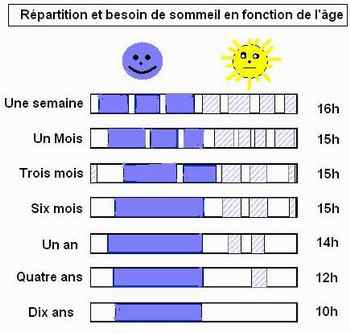
- Source: Prosom
After 6 to 8 years, the nap is, usually, no longer necessary.
Its persistence is often linked to a gradual delay of bedtime (Television +++), whereas getting up remains fixed (because of school).

The teachers often notice problems of excessive daytime sleepiness linked to too late bedtimes, but the practice of the nap in this context risks to worsen a sleep onset insomnia in these children who are often disturbed by the excessive noise in the house in the evenings (TV, older children).
The methodical use of a sleep-wake diary often allows to highlight the inadequacies between the child’s needs and its sleep schedules.
Recent studies have put forward the inadequacy of the current schedule of school time (8 AM or even less, sometimes) with the sleep rythm of one third of the children.
Cf. "Sleep insufficiency"

- 5 years old child
From 4 to 6 years, at the moment when the nap disappears, sleep will become very deep during the first part of the night. Often, the first sleep cycles contain no REM sleep phase, but only slow deep sleep. The first phase of REM sleep will only occur after 2 or 3 hours of sleep. (Cf. "Know how to sleep")
During the "sleep one dreams of" period, that deep sleep has trouble getting lighter. The transitions to another state of arousal will be difficult.
These characteristics explain some sleep disorders related to slow deep sleep, like nocturnal terrors or sleepwalking.
These parasomnias are frequent and generally not worrying at that age.
![]()
Unsuited school rythms and sleepiness in children
![]() According to the articles of the last congress of sleep medicine, one child in three is "penalized" by the school time schedules.
According to the articles of the last congress of sleep medicine, one child in three is "penalized" by the school time schedules.
The individual variabilities of the chronobiological rythms do that these "evening children” have a lot of trouble falling asleep early enough to be at school on time.
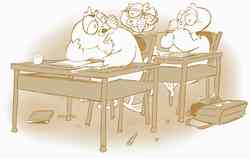
![]() Read the opinion of Hubert Montagner, Director of research at the INSERM, Director of research in developmental psychophysiology and psychopathology at the University of Bordeaux II:
Read the opinion of Hubert Montagner, Director of research at the INSERM, Director of research in developmental psychophysiology and psychopathology at the University of Bordeaux II:
" A holidays period is ideal to know the child’s rythm.
In the classroom, yawning, rubbing the eyes, stretching are signals of sleep disorders.
Yet, these phenomenon are not always taken into account : intermediate places should be created where the child could finish to wake up when it arrives at school. It can, then, be more receptive and trustful during the class hours.
The best would be to make the important lessons match the periods of optimal receptivity of the child. That could result in a lot of timesaving!
The ideal being a 5 days’ week, with more flexible hours: from 9.30 AM to 12, and from 3 PM to 5 PM."
![]() In an article in the French newspaper "Le Monde" (from 07/04/2001), "the scientists lose hope of ever being heard..." (Nda).
In an article in the French newspaper "Le Monde" (from 07/04/2001), "the scientists lose hope of ever being heard..." (Nda).
The teenager’s sleep :
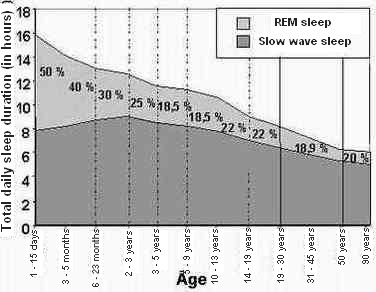
- Source http://ura1195-6.univ-lyon1.fr/
The teenager’s need for sleep is similar to that of the pre-teenager (in average 9 hours +/- 2h per day)
The teenagers like to go to sleep late and enjoy the end of the day. That tendency is also biological, probably linked to the hormonal changes during puberty but, in fact, its physiological need for sleep does not decrease.
During that period, sleep becomes lighter in the start of the night and sleep onsets are more difficult. An important reduction of the night sleep time follows from that.
There exists, thus, very often, a chronic sleep lack in the teenager (a reduction that reaches nearly up to 2 hours a day between 12 and 18 years). To compensate that debt, the teen sleeps over during the week-ends and the holidays.
The sleep schedules become irregular, a reappearance of daytime sleepiness can often be noticed, with yawns and need for a nap. It is also the period when numerous functional disorders appear : headaches, eyelid spasms, dizzy spells, «spasmophilia (or tetany)», which witness for the lack of sleep, quantitative as well as qualitative, that occurs at that age.
![]()
Launch a (2 mn.) excerpt from the press conference of January, 29th, 2007. PARIS, France: introduction of the program for the actions for sleep by Health Minister Xavier Bertrand.
Measures
for the child and the teenager
Sources: http://www.morphee.biz
Note from the author of the website.
The teenager’s sleepiness is linked to the "plastic" performances of sleep at an age where it is easy to adapt to the constraints of the rythm of life.
Still, it is impossible to decrease one’s need for sleep (even if it is possible to learn to sleep less).
If the "energetic balance" is negative, the subject is bound to doze off and to suffer from a diurnal loss of performance.
BUT IT IS NOT THE CASE OF THE SHORT SLEEPING TEENAGERS!
Conclusion
The common sense pleads for the child having a nap on Sundays or during the holidays. Yet it is the age when sleep is organized best and it is rare that a child who needs to sleep doesn’t take pleasure in it.
On the other hand, it appears clearly that some insomnias of the adult find their root there if the child is never sleepy.
On the opposite, after 8 or 10 years, a persisting excessive sleepiness (a need for sleep that cannot be reduced) must lead to an exploration of sleep
Teenage is a period when the nap becomes beneficial again (or even necessary) in many subjects.
But it is an age when its virtues and instructions for use are not known.
A better spreading of the knowledge about sleep amongst teenagers has become a national public health priority.
At the age of the driver’s licence, the practice of preventive or recovering naps could, that way, avoid a large number of terrible dramas.
NB : the excessive intake of alcohol does not explain, alone, the traffic accidents, because sleepiness might be implicated in one out of four accidents but there exists no "somnotest" to measure the additional effect of the sleep debt and of the circadian clocks at the moment when someone hits the road.
NB :The "PAS 2007" (Program of Actions for Sleep)
What changes should occur in schools ?
Education and making the young ones aware since their early childhood.
During the first six months of 2007, posters labelled «Long wake, ruined day», educative documents «Sleep, my friend» and «Looking at sleep with open eyes» will be distributed through Family Planning Services, Child Benefit Offices, health insurances offices, and the French National Associations for Family Child Care in order to make the parents but also directly the young people sensitive to the importance of an adapted sleep time.

- Sleep, my friend
In the new convention between the Health Minister and the National Education Minister, sleep stands in a good place so that the school doctors and nurses are aware of the child’s sleep. Education tools to raise the high school pupils’ awareness of the effects of noise on sleep are being worked on with the collaboration of the Ministers in charge of ecology and culture in the context of the national plan against noise pollution. .
In September 2008, the teachers will have a CD about sleep of children and teenagers at their disposal.
In the start of the school year 2007/2008, the education professionals will have education tools and will receive a specific teaching in the IUFM.
Information about sleep will be inserted into the "tips" sections of the new health carnet.

- Quelques liens externes pour en savoir plus...
-
English sleep links for young people:
- Sleep for Kids ( "Hi, I’m P.J. Bear!In this website for kids, you can learn about what happens while we sleep, play fun games, and keep track of your own sleep. ").
- Awake at the wheel (Pdf English)
- Sleep, dreams and children (a very complete scientific file - in French) Challamel M.J., Thirion M.
- The advice leaflet from ProSom ADESI; questions/answers :"the infant’s sleep" (in French)
- The chronobiologist’s opinion about school rythms (in French) (Inserm 2001)
- From the biological clock to the school rythms (in French) (Pdf 4 p. A collective expertise from the Inserm, of 2001).